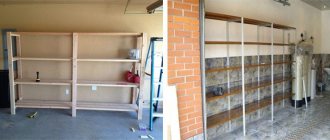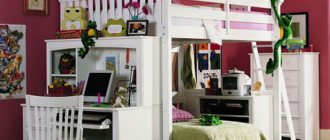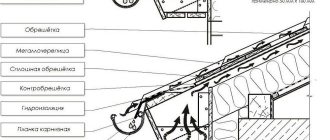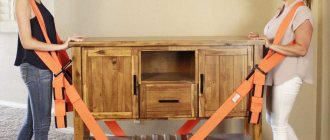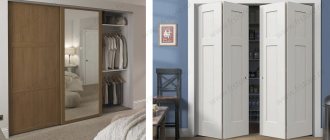Materials and tools
To assemble the cabinet you will need:
- Boards. The best option is pine. As for quantity, you should focus on the desired sizes. An important point is the thickness of the material. The fact is that a closet usually uses not only shelves, but also the walls themselves. Accordingly, if you plan to place heavy metal tools on the walls, then the board should be selected with maximum thickness.
- Plywood. This material is used to create partitions. You can also use it to make the back wall of a cabinet if you do not plan to store heavy tools or use the wall as a “shelf.” But such sheets are not suitable for the bottom, since they cannot withstand heavy loads. Again, the amount of plywood is determined by the dimensions of the box and the partitions.
- Beam. It is best if it is made from the same type of wood that was used in the boards. It will be needed to equip the cabinet with legs or runners. The optimal size is 50x50.
- Metal corners. Here you only need those elements that are used in the construction of furniture, as they are characterized by increased strength. If you want to make a closet with opening doors, then you should immediately take care of the hinges.
- Screwdriver. The tool will need appropriate drills and bits.
- Electric saw or hacksaw.
- Furniture screws. But when purchasing them, you immediately need to take care of special nuts for them. It is advisable to opt for brass products, since this material is highly resistant to moisture. This is especially important for those who plan to place their closet on the balcony.
- Self-tapping screws. These fasteners will be needed to secure the auxiliary fasteners. Here you can get by with galvanized elements. But in addition, it is worth keeping nails on hand, although some recommend discarding them, since wood tends to dry out, which means that the fastening will weaken over time.
Once all the materials and tools are on hand, you can start working.
Simple tool storage cabinet
Often in life a problem arises when you cannot quickly find the right tool in a workshop or at home.
The reason for this is often that it is impossible to remember where you left what when there are many tools and the search area is large. I'm not even talking about those cases when one of the relatives took the instrument and moved it. To avoid such problems, build yourself one good closet where everything you need will be stored. If you always return the tool to it when you use it, you will no longer have problems finding things.
The author made himself such a cabinet; it has 6 drawers. Four of them are small in size and are used to store small items. And two drawers are large, they are located at the very bottom of the cabinet. Everything is done simply, glue and wood screws are used, and plywood and boards are used as materials. It is not at all necessary that the material be new.
Materials and tools used by the author:
List of materials:
- sheet of plywood; - boards; — handles for drawers (the author used parts from water taps); - glue and screws for wood - slider for shelves (guide).
List of tools:
- drill with drills; - screwdriver or screwdriver; - clamps; — oil for impregnation; - pliers; - a circular saw; - building level; - pencil, ruler and other measuring instrument.
Cabinet making process:
Step one. Cabinet design
First of all, the author took all the necessary measurements and developed the design of the cabinet. The furniture was made from almost waste materials that the author found on his site. It was mostly oak and cherry. Of course, the materials should not be rotten, cracked, and so on.
Step two.
Making boxes Boxes are made very simply, and the author decided to start with them. Here you will need plywood, as well as boards. The boards need to be cut to the required sizes; for each box you will need four blanks. You need to cut grooves along the bottom of each board; they will be needed to install the plywood. We cut the plywood to the required size, and drill holes in the boards for screws. If desired, you can apply glue to the grooves, so the plywood will hold more securely, but this is not necessary. That's all, the shelf can be assembled, just screw in the screws in the right places. Finally, we sand the drawers and paint them. The author used a cherry-colored dye.
Step three. Front part of shelves
You will need some materials to finish the outside of the shelves.
The author used cherry boards for such purposes. We cut them to the required size, sand them, and then simply glue them to the shelves. We clamp the whole thing with clamps and let it dry completely. Once the glue dries, you will need a drill.
Use it to drill a hole in the center of the face board. This is where the bolt or screw that is used to secure the arm will be inserted. Finish with 320 grit. Step four. Assembling the frame
The author assembles almost the entire frame using glue; if desired, you can use dowels or screws.
For assembly, cherry wood slabs, boards, and thin blocks were used. When cutting wood boards, you will need three parts, the largest back and two smaller sides.
It is most convenient to cut on a circular saw. You will also need to cut all the necessary components for the frame from boards or beams. Next, you can begin assembling the frame. The author drills holes in the right places and assembles the frame with wood screws. To be on the safe side, you can also combine this with wood glue.
After assembling the frame, you can install the walls. We just put them in place, and then make slits at the corners of the frame. They should be of such depth that they reach the wood boards. You can insert plywood or pieces of wood boards into these slots. Of course, these parts are thoroughly lubricated with glue and hammered into place.
When the glue dries, we cut off the protruding parts and thoroughly sand the entire structure. The author used 320 grit sandpaper as an abrasive.
Step five. Cabinet finishing
For the side and back walls, the author used low-quality materials.
The slabs absorbed moisture for a long time and did not look very good visually. In this regard, it was decided to decorate them on the outside. We take the finishing material, cut it into the required pieces and glue the outside of the cabinet. We use good wood glue and clamps. Step six.
Installing sliders The sliders (guides) are purchased from the author, they are made of metal.
Using a measuring tool, attach them to the box using wood screws. As for the moving part, we screw the block to it. Next, this block is screwed to the drawers themselves. We drill holes, screw in screws, nothing complicated. The main thing is to do everything smoothly, otherwise the boxes will jam. Step seven.
Assembling and installing the handles And now about the most important thing, the handles. This is the main component of the cabinet, which at first glance says that it is a tool cabinet. The author decided to use handles from old faucets as handles. To assemble one handle you will need a long bolt, a nut, three washers and a piece of metal tubing.
First we insert the bolt, then we put the washer and tube on it, and again we put the washer on top of the tube. Now put on the faucet handle, with a washer and nut on top. That's it, the handle is installed, there are still 5 pieces left.
Step eight.
Making a tabletop The tabletop is made from boards, cut them into pieces of the required length, and then glue them together with a ladder, but it is not necessary to use this approach. After the glue has dried, level the tabletop using a circular saw.
Finally, you will need to make a border; it will emphasize the appearance and strengthen the tabletop. Here you will need boards, cut them to size, and then attach them to the manufactured slab. The author uses wood screws for fastening. Finally, sand the countertop, making it absolutely smooth and even.
Step nine.
Final assembly and finishing touches For the tabletop to be securely attached, it must have reliable support. For these purposes, the author screws supports made of boards to the top of the table. Now the tabletop can be installed, how to do it is up to you, you can simply glue it. The author screwed the tabletop from the inside to the frame, so securely. Finally, sand your creation if it has any imperfections, and then treat it with oil, varnish or another coating. Oil will make your closet as natural as possible. If the wood used is of poor quality and does not look good, the furniture can be painted and then varnished.
That's all, the cabinet is ready, now the author has complete order on his desktop and does not have to constantly look for a tool.
Source
Become the author of the site, publish your own articles, descriptions of homemade products and pay for the text. Read more here.
Assembly steps
Tool cabinet yourself
To assemble a tool cabinet with your own hands, you need design drawings.
You can create them yourself, or you can simply find an interesting option on the Internet.
In the first case, a simple sketch will do.
The main thing is to determine for yourself the dimensions of the back and side walls, and also pay attention to the parameters of the lid and tray.
The main thing here is not to forget that when planning shelves, it is worth remembering the thickness of the boards, which will “eat up” a certain part of the space.
To create a tool box, you must perform the following steps:
- To make the legs, the timber is sawn into 4 identical cubes (50x50x50). It is recommended to fix them on runners made of the same material. The runners themselves are attached perpendicular to the sides of the cabinet, which indicate the length.
- Next, all wooden elements are processed. For such purposes, an antifungal solution is used. It will help protect the wood from rot and mold. As soon as the coating has dried, all parts are coated with wood primer, and when this layer is dry, Aquastop is used. BUT! Such work is carried out only with planed boards, and it is advisable that all materials are pre-cut into the required size parts.
- The first thing that is assembled in the closet is the frame. According to the drawing, the boards are adjusted according to the parameters, after which the side walls, bottom and lid are assembled. In the case of narrow elements, it is allowed to use two combined boards, but the main thing is to ensure that there are no gaps at the joints. Fixation is carried out using self-tapping screws. Thus, an external frame on temporary fasteners should be obtained.
- Now proceed to the main fixation. For these purposes, all connecting points are secured using furniture corners. Here, too, self-tapping screws or nails are used first. Next, furniture screws and nuts are screwed in, after drilling the corresponding holes in the right places. The most difficult part is drilling the holes at the end of the stroke in the shelves, lid and bottom. As a result, it turns out that their ends will have drilled holes. IMPORTANT! The length of the drill is selected to match the length of the screw.
- Now let's move on to the legs. A beam is attached to the bottom of the box, on the reverse side, like runners. There is no need for heavy-duty fasteners, so you can get by with simple self-tapping screws. Next, pre-prepared legs are mounted to them in the corners.
- As for the boxes, this work is carried out by knocking down a frame of the desired shape and size, where the bottom is nailed down. If shelves are needed, cuts are made on the inside where the partitions will be installed. They can be made from plywood.
If desired, doors can be attached to such a box, after which the entire product is varnished.
Video with simple DIY cabinets
After assembling the cabinet, be sure to treat the wood with an antiseptic, you can coat it with colorless varnish or impregnation!
Leave your tips and comments below. Subscribe to our newsletter. Good luck to you and good luck to your family!
← Previous post
Next post →
Arranging the tools
It was described above how to create a simple box, but in order to use it conveniently, its internal space must be ergonomic. For such purposes, shelves, drawers and hanging hooks are organized. This issue can be resolved this way:
- Upper compartment. To create shelves, you can use the same boards that are fixed inside the frame. It is permissible to fix them on ready-made hooks or by drilling holes in the ends (on the outside of the box) and place them on self-tapping screws. Such shelves can easily withstand the weight of small tools or boxes of nails and screws.
- Bottom part. For convenient use, it is best to make only one shelf in the lower compartment. More massive instruments can be placed on it. If you wish, you can install a folding table here.
Read also: Device for measuring curved lines on a map
There is also an option for mounting tools on the walls. It’s worth saying right away that all heavy elements should be located in the central part, but lighter tools are hung on the doors (if there are any).
Cabinet assembly diagram
Usually loops, nails or other elements are used for this, but boxes can also be placed. To ensure that they always remain in their places, they are placed on glue or screws.
The quantity and shape of the internal filling of the box directly depends on the needs. The more building material there is, the more shelves and compartments need to be created.
Selecting a location and preparing for production
The first thing you will need to do is choose a location for the cabinet. Books also require compliance with basic hygiene rules. Careful storage of the library means its location away from heat sources and out of direct sunlight. Otherwise, the paper fibers will become brittle and brittle. Excess humidity can also cause irreparable damage, so the bookcase should be installed as far as possible from the kitchen and bathroom.
When the location is chosen, the size and type of the future structure are determined. It can be open or closed, that is, have doors on the front part. To store books, it is recommended to choose the second option as it more reliably protects them from dust, excess humidity and temperature changes in the room.
Assembly diagram of a cabinet with removable shelves.
The doors can be made of wood, but the cabinet will gain greater elegance and beauty if it is equipped with tinted glass. There are different models of cabinets: built-in, modular or corner.
For the first time, making a bookcase with your own hands is better, using the simplest configuration and inexpensive materials.
The entire manufacturing process can be divided into the following stages:
- creating a drawing;
- ordering cutting of chipboard and MDF;
- ordering tinted glass for facades;
- delivery of materials;
- drilling assembly holes;
- furniture edge sticker;
- assembly of the structure;
- installation of facades and glass.
Improving the tool box
Depending on where the tool cabinet will be located, on the balcony or in the storage room, you can make its lighting with your own hands. This will significantly improve ease of use. There are several options for resolving this issue.
For those who understand electricity, we can offer automatic backlighting. Future lighting fixtures are marked in the box and holes are cut for them so that it is possible to install a base.
It is advisable that the product is already in place, since the next step will be choosing the length of the electrical cable. It is fixed to the wall or ceiling using screws, after which it is placed in the lid and closed. Next comes the sequential connection of the backlight to the cable - first phase, then “zero”.
IMPORTANT! Any work with wires and other elements is carried out only with the electricity turned off. Now the lamps are screwed into the base and the work is checked.
Halogen lamps. This option is suitable for a large box to illuminate its shelves. Typically, such kits are sold as ready-made kits consisting of:
- switch
- transformer
- halogen lamps
- connector
- wires
Initially, lighting is marked, after which holes (0.5 cm) are made with an electric drill and cutter. After this, the cutter is turned over and the points are completed.
If this is not done, there is a risk that the tool may seriously damage the wood, which will require you to redo the shelf or door.
According to the diagram, all the elements on the floor are connected into a single chain, after which the lamps are connected to a transformer and the operation is checked. For parallel connection, blocks and terminals are used.
In order for such lighting to work fully, it is worth remembering the following important points:
- transformer power ratings should be 5% higher than the total power of the lamps themselves
- minimum power output from the transformer is 12 volts
- pay attention to the operating voltage indicators of the lamps themselves
- For the backlight to work well, the maximum cable length should not exceed 2-3 m
- the transformer is mounted in a place so that it does not heat up from other sources (battery, heater, etc.)
Mini workshop with lighting
Perhaps the easiest way to outfit your toolbox with light.
But this does not mean that such light will be ineffective.
LED strips are sold in reels, and you can buy a specific meter or take one reel, in which 5 meters are measured at once.
Additionally, you will also need a plug and wire to connect the entire system to the mains, as well as a power supply and controller.
The work has the following stages:
- first connect the unit with the cable, and then connect the controller to the power supply
- 4 multi-colored controller wires are connected to similar colors on the tape using a soldering iron or terminal blocks
- to check, connect the plug to the socket and see if all the lights are on
- Each tape on the reverse side has an adhesive backing, which is covered with a protective film - gradually removing it, the tape is pasted in the necessary places for illuminating the box
If desired, you can purchase multi-colored ribbon. As for the intensity of lighting, it all depends on the density of light bulbs per 1 square meter. m. - the more there are, the brighter the light.
Making tool box lighting is actually not that difficult.
DIY cabinet made of timber. Making a wooden cabinet with your own hands
Wooden furniture has always enjoyed deserved popularity. It is strong, durable and can last more than 100 years without losing its qualities. What is important is that wooden furniture looks beautiful and prestigious. It is these factors that often become incentives in the decision to purchase this furniture. But you don’t have to buy it at all, because making it yourself is not as difficult as it seems. This article will discuss the necessary information and the process of making a wooden cabinet with your own hands.
The cabinet has a unique design.
The benefits of creating a wooden cabinet with your own hands
Making furniture with your own hands has many advantages:
- high-quality materials are selected personally and are much cheaper than materials from a factory to order;
- making a cabinet out of wood with your own hands is not very difficult, since wood is easy to process;
- getting the desired result is quite simple if you have the necessary tools;
- making furniture can also bring moral pleasure and become a creative hobby, because it’s nice to independently achieve your goal.
It will help place all the necessary things in the room, and with its originality will add a touch of extravagance to the living room.
To make such a cabinet you will need plywood slabs or boards.
With the right execution technique, a homemade piece of furniture can be even better in appearance than factory-made furniture.
Solid wood furniture can be any structure that must withstand heavy weight.
To install adjustable legs, holes are drilled in the bottom of the cabinet.
How to decide on design and construction?
The cabinet model is selected depending on its location and the required technical characteristics (capacity, width, etc.), and the design and construction depend on the general style of the room and the purpose of the cabinet (storing clothes, dishes, books or other things).
- For small rooms, sliding wardrobes are the most convenient due to sliding doors; they are made to fit a certain room size, and can be installed even in the narrowest spaces, such as a corridor. The necessary accessories can be purchased at a hardware store and finding materials is not a problem now.
- A large and spacious closet with many shelves, drawers and several hanging rods is perfect for the bedroom. They can be equipped with shelving, doors with the required number of doors, retractable structures and doors (sliding wardrobes). We must not forget to take into account the overall design of the space, which will become the basis for choosing the cabinet design.
- Natural wood furniture is also in great demand for the kitchen. The kitchen set consists of a large number of drawers and small cabinets with doors. Building kitchen cabinets will require a lot of materials and effort, but the results can be worth the wait.
- Furniture in bright and cheerful colors will look good in a children's room. The wardrobe can be decorated with mirrors, drawings and ornaments. Additional shelves for toys are also important. It is also necessary to find out the wishes of the child, because the closet is designed specifically for him.
- A small closet with several shelves is suitable for a bathroom. There may be a mirror on it. Making such a design will not be difficult for those who know at least a little the basics of carpentry.
A few final tips
The design of a homemade box is so simple that even a novice craftsman can handle it. The main advantage is that there is no need to use expensive tools. But there are a number of recommendations that will greatly facilitate the operation of such a product:
- You shouldn’t immediately equip the entire space with shelves, as over time there may be a need to expand it
- when there are a lot of heavy tools in the house for which a cabinet is being built, then it needs to be additionally reinforced with aluminum corners
- a portable box is always convenient, since it is possible not only to change its location, but also to take it with you to the dacha
- If you make it yourself, you can easily add some functional compartment even at the drawing stage
A DIY toolbox is not only an organized storage place for tools, but also a reason to be proud of yourself.
You can watch the video to see how to make a tool cabinet yourself:
Noticed a mistake? Select it and press Ctrl+Enter to let us know.
Tools are available in every home. Especially if there is a man in it who loves and knows how to make something with his own hands. Then there is simply an incredible amount of tools. After all, in a good economy everything will come in handy.
Diagram of installation of fasteners and fastening of shelves.
A hammer, screwdriver and pliers, which are often used for basic work, can be placed anywhere.
But a large number of tools requires a good and convenient cabinet. It should accommodate the entire tool and also not take up too much space.
Cabinets, bedside tables, and chests are used for these purposes. Hang the instrument on the wall in the hallway or glassed-in balcony.
Assembly diagram of a wall cabinet for tools.
You can, of course, use all of this. But making a tool cabinet with your own hands is not at all difficult. And this is the optimal solution. Indeed, in this case it will be ideally suited for the needs of the home craftsman.
Read also: How to properly charge a car battery
There is a wonderful option for such furniture, which is a cabinet with two doors. The doors swing open, and in the middle part of the cabinet there is a folding table. It is convenient to use for work. You can install separate lighting in the closet, which will further increase comfort. When closed, it takes up very little space, so it can be installed in a small city apartment. For example, on the loggia. Such furniture will satisfy the needs of the most picky craftsman.
DIY tool cabinet (installation of an additional drawer on a hinge)
The idea itself was spinning in my head for quite a long time, but since there was no necessary material at hand, I had to constantly postpone its implementation. But after the construction of these shelves and racks, there were quite a lot of various pieces of chipboard left. Actually, after that I decided to put together a small box in a tool cabinet so that it could be pulled out when necessary, that is, it would be on a hinge. Initially, it was an ordinary closet in an apartment, converted over time into a tool cabinet. It would be possible to stupidly hang it with deep shelves from the far wall, right up to the door, and not bother anymore. But deep shelves have one big drawback: over time, they become cluttered so much that it becomes difficult to reach the far corner to get something very necessary. And according to the law of meanness, everything you need, as a rule, lies in the far corner.Therefore, in this cabinet I decided to simply hang many small and not very deep shelves for a specific tool or material. The photos below show what came out of it. I hung them in the middle part of the cabinet, mainly under bolts, screws and power tools, so that under them there would be a large pull-out shelf, and under it a compartment for the compressor and paint sprayer. Also along the edges of the cabinet, a pair of lighting threads was built in, which turns on when the door is opened.
The photo below shows that after this upgrade, there was an unused void in the middle of the cabinet. It was in this place that I decided to attach a small drawer, thereby increasing the usable area for a variety of tool junk.
These are actually bits of chipboard from which I will assemble the box.
This is what it looks like in the end. Twisted with regular screws and iron corners.
It was supposed to be taken to the side like an ordinary door. But since this drawer will be located somewhat deeper, relative to the cabinet door frame, I had to build hinges like these so that they could be used to pull the drawer out of the cabinet.
Actually, the box is already screwed into place. At first glance, everything seems great, but as soon as you open it, all these hinges begin to break. And as a result, this box hung diagonally, and this is taking into account the fact that there was no tool in it yet.
In general, I had to give up these furniture hinges and ask my friends to weld something more powerful. As a result, we got this noose made of thick sheet iron, round timber, nuts and a corner, on which you can now safely hang yourself, and it won’t even bend 
Since the entire mass of the toolbox will fall on the lower part of this hinge, then in the upper part of the hinge, the corner is made of a thin strip, because the loads there are minimal.
Here you can see a cardboard template from which the dimensions of the hinge were measured so that the box could freely sink into the cabinet.
A base was also cut out of sheet iron on which the box would rotate.
We transfer the mark of the hole for the pin from the cardboard template to a sheet of iron and drill it out.
After that, we screw this piece of iron to the base of the box.
At the end, I lightly lubricated all the rubbing surfaces of this hinge with grease, put this box on the pin of the lower support and secured it, screwing the upper edge of the hinge, to the box. On this powerful hinge, the drawer now rotates easily and effortlessly with one finger.
On the back side of this box, I screwed fragments of galvanized strips, which act as spring-loaded holders, holding an oversized tool in the form of various hacksaws for wood and metal.
A little video showing this box in action.
Unfortunately, I have not yet begun to completely inhabit this box, building into it various cups and cells for open-end wrenches, screwdrivers, drills, hammers and other tools, because over time I stopped liking the method of opening this box. The idea itself is not bad, but only if the door opens rarely or automatically. And so, during some minor renovation in an apartment, sometimes you have to poke your head into this closet a dozen times and waste precious time pulling the drawer out of it. Now we are planning to move this drawer to the door, so that when you open just one door, all the tools will be like in the palm of your hand, that is, in one movement of the hand. But to do this, you need to change the door itself, since this one is very old, loose (chipboard), slightly curved and with weak hinges.
The idea itself is not bad, but only if the door opens rarely or automatically. And so, during some minor renovation in an apartment, sometimes you have to poke your head into this closet a dozen times and waste precious time pulling the drawer out of it. Now we are planning to move this drawer to the door, so that when you open just one door, all the tools will be like in the palm of your hand, that is, in one movement of the hand. But to do this, you need to change the door itself, since this one is very old, loose (chipboard), slightly curved and with weak hinges.
Write a message to the author Author: Nikolay Golovin — — — — — — — — 07/12/2013
Other site pages
When copying materials from the site, an active backlink to the site is required. Author: Nikolay Golovin / My hosting provider BeGet.ru 04/12/2012
List of materials
For this you need:
- pine boards;
- plywood;
- wooden blocks;
- hacksaw, hammer, nails, screws;
- metal corners;
- hinges and other fittings.
Before you start making a cabinet, you need to decide on its location in the house and, accordingly, its size. For example, there is free space - two meters along the wall. If the central part of the cabinet is 100 cm wide, then the doors should be 50 cm each. When opened, they will take up these 2 meters of free space. The height, for example, will also be 2 meters. That's it, the sizes are determined.
Now you need to take the prepared lumber and cut it to size. The back of the cabinet, as well as the back (and at the same time the front) of its swinging doors, can be made of thick plywood. The side walls are made of boards. The boards can be connected to each other with metal corners.
Rack arrangement diagram.
As a result of this work, you get three identical rectangular boxes. Now the task is to attach the sashes on hinges or hinges to the central part so that they open and close easily. But before you do this, you need to secure the central part of the product to the wall. High-quality fasteners are important here, since, given that the table will recline in the cabinet, it will bear a large load. The cabinet must be attached directly to the wall using metal corners. The corners are attached to the boards. Holes are pre-drilled in the wall into which the choppers are driven.
After the central part of the product is secured, you can mount the table. It consists of a wooden board that hinges down into the bottom of the cabinet. From below, on the tabletop, 1 or 2 folding legs are fixed. The same on the hinges. Door hinges can be used. But they must be quite massive and firmly fixed. The tabletop should not be too large so as not to increase the load on the cabinet. When folded, there should still be free space underneath it.
The next stage of work will be fastening the opening sashes. They need to be adjusted so that the movement is smooth and they fit perfectly. To fix the shutters in the open state on the wall, you can provide special fasteners.
Making a cabinet
After you decide on the color of the chipboard, you will need to cut the materials according to the project you made. In this regard, we can only say that this part of the work should be performed by specialists. Usually, when you buy chipboard, you can order sawing at the same store. If you want to save money on this and cut the material with a jigsaw, you should be prepared for the possibility of chips.
After this stage of work is completed, it’s time to select fittings for the cabinet. Before you do this, select the type of system that will be used to open and close the doors. At the moment there should not be a problem, you can choose from a large number of different options. This can include movement up, down, sideways, as well as a coupe system.
Having calculated how many shelves there will be, as well as doors in the closet, do not forget to purchase the required number of confirmations, such parts as guides for drawers, and at the same time, do not forget about holders for shelves.
Tool holder
Drawings of tool cabinet parts.
The next important point in the manufacture of such a cabinet is the mounting of various tools in it. After all, this is exactly what it was created for.
Of course, all heavy tools should be located in the central part, which is securely mounted on the wall.
Lighter things are located in the doors, as moving parts. You can make full use of your imagination to ensure that everything is at hand and the tool is convenient to use.
For example, you can attach metal or plastic boxes with various small things to the doors: nails, screws, bolts, etc.
At the very bottom of the central part, you can provide mounts for heavy tools, such as a hammer drill or grinder.
Lighting installation
Of course, you can also install a portable table lamp with a clothespin mount. But it is much better to provide separate lighting for such a cabinet. In addition to the lamp, you can also provide an outlet located so that you can conveniently plug in a power tool there. If desired, you can even run a separate line from the electrical distribution panel. The line must be connected through an emergency shutdown circuit breaker.
Well, the tool cabinet is ready. It remains only to pay attention to the external decoration, so that when closed it fits well into the interior of the room. Don't forget about door handles. If there are small children in the house, you can provide a latch or lock.
This closet is very convenient. Not only does it allow you to store a large number of tools and everything that can be useful for a home craftsman, but it also represents a mini-workshop with electricity and a small table.
After reading this material, the question of how to make a cabinet to place home tools in it disappears by itself. After all, the description is quite detailed.
How to do something yourself, with your own hands - home craftsman website
AN EXCELLENT TOOL FOR CRAFTERS AND HANDCRAFTS AND EVERYTHING FOR THE GARDEN, HOME AND Cottage LITERALLY FOR FREE - SEE FOR YOURSELF. THERE ARE REVIEWS.
Nothing can replace a mobile chest of drawers that helps organize storage and tidy up your workshop. It'll hold the tools you use frequently so you'll always have them within reach, but you can easily tuck it out of the way or roll it to your workbench. Does it have any disadvantages?
Most of the hefty, rugged commercial models sell for exorbitant prices. But you can make such a chest of drawers yourself by taking several sheets of birch plywood and available fittings. Customize it exactly to suit your needs and enjoy admiring your work every time you pull out the drawer.
TOOLS FOR HOME AND GARDEN, HANDCRAFTS, ETC. PRICES VERY LOW
Construction of the tool cabinet body
1. Start by cutting out the parts of the upper body: side walls A, top and bottom panels B and back wall C according to the dimensions indicated in the “List of Materials.” Sand all parts with 220-grit sandpaper.
Attach the side walls with screws to the top and bottom panels (Fig. 2, photo A). After checking the squareness of the assembly, add the back wall and secure with screws.
Read also: How to make a homemade snowmobile from a walk-behind tractor
2. Cut out frame D of the upper body. Apply glue to one edge of the piece and glue it to the bottom panel B, aligning with the front (Fig. 1).
3. Cut out the side walls E, the top and bottom panels F, the back wall G and the frame H for the lower body. Assemble the lower body in the same order as the upper one.
4. Cut out four corner bosses from 25 mm thick material and glue them from below to the corners of the bottom panel F (Fig. 1).
While pressing the box wall blank against the wooden pad, adjust the position of the longitudinal stop to align the face of the blank with the outside of the disk. Since the cuts are not through, it is safe to use the longitudinal stop as a limiter when forming grooves in the side walls J, K. By moving the longitudinal stop close to the disk, but without interfering with free rotation, cut the folds along the ends of the front and rear walls.
Making a cabinet from solid pine at home: step-by-step instructions
This breed has a soft structure, so it can be easily processed in any way. Doesn't rot. Natural solid raw materials have a good effect on the indoor microclimate.
A pine cabinet will fit perfectly into interior styles such as:
But before you start work, it is worth preparing a visual drawing of the future structure, where the dimensions of all parts will be outlined, and the frame with the location of the internal shelves will be shown.
Dimensional diagram of the cabinet frame
Using this scheme, the quantity of materials is calculated and the overall cost estimate is calculated.
When purchasing raw materials, you should pay attention to:
- uniformity of wood relief;
- absence of layers, knots;
- dense arrangement of growth rings.
Otherwise, the pine will not be strong enough, which will significantly reduce the service life of the product.
What materials and tools will be needed
You need to prepare in advance:
- hand or power saw;
- roulette;
- grinding machine;
- hammer;
- wood slab;
- metal corners;
- dowels, screws, nails;
- mastic;
- jigsaw;
- electric drill with wood drill;
- chisel;
- screwdriver;
- level and angle for measuring inclination;
- varnish;
- construction stapler;
- pine timber 40*40 mm;
- solid boards;
- sheets of chipboard, plywood;
- slats.
Selecting the necessary accessories
You should consider how the doors in the closet will open: sliding, hinged, or use telescopic guides.
To save money, it is allowed to use fittings from old furniture.
Preparing product parts
Frame parts can be cut by hand. Another option is to create an individual order, and the craftsmen will cut out the parts for you according to the provided drawing.
Of course, cutting and grinding yourself is a labor-intensive process, but it saves the family budget.
Let's consider making a cabinet measuring 1.8 m*1.5 m*0.5 m (height*width*depth) with hinged doors.
For the upper and lower frames, a total of 4 m of pine timber will be required, and vertical posts - 7.2 m.
We measure a sheet of chipboard or thick plywood for the back wall, top, floor.
Assembly
The assembly guide looks like this:
- The rear and front frames are assembled from timber. The parts are connected to each other with self-tapping screws. To add rigidity, corners are installed in the corners.
- Cross bars are installed.
- The floor, top of the cabinet and back wall are cut out of chipboard sheets. They are attached to the beams with a stapler.
- A shelf made of boards is immediately installed, which will divide the cabinet into two parts, fixed with self-tapping screws.
- At the next stage, guides under the shelves are mounted from slats on self-tapping screws, and pre-cut and sanded shelves from boards are installed. Their length should not be greater than the depth of the cabinet. To prevent them from jumping out of the grooves, it is better to also place them on self-tapping screws.
- Next, a frame for the timber doors is formed. The parts are connected with nails and angles. For reinforcement, it is recommended to install a jumper diagonally.
- The frame is covered with boards, plywood or clapboard.
- Handles, trims, hinges are attached.
- Curtains are installed. Doors are hung.
- In the second part of the cabinet, a pipe holder for hangers is placed on the fastenings.
- Legs are installed.
Upon completion, the operation of the doors is checked and there are no gaps between the parts.
A smaller cabinet can be made wall-mounted or, to save space, built into a balcony or glassed-in loggia.
Varnishing the product
You can highlight the beauty of natural wood by covering it with varnish.
It is better to consider the description of this processing step by step:
Photo: wood varnishing process
Lovers of antique style can decorate the cabinet with their own hands in an antique style, adding age to the wood artificially.
These articles will be useful
:
At the dacha, terraces and verandas are furnished with such furniture. It will fit well into the Provence and country style, if you choose the right curtain fabric and other details.
In addition, the product can be painted in colors close to natural, or treated with wax mastic.
Make drawer parts
1. Cut out the side walls J, K and the front/back walls L, M for large and small drawers. Also prepare a 12mm thick scrap for tuning and set it aside.
Quick tip! Want to add partitions? Make grooves 6 mm wide and 3 mm deep on the inside of the front and rear walls L, M. Once the boxes are assembled, insert strips of 6mm plywood into them.
2. Install a 6 mm thick mortise disc and an anti-splinter insert into the saw machine. Attach a wooden plate to the longitudinal (parallel) stop. Raise the disc to a height of 6 mm and fix the longitudinal stop at a distance of 6 mm from the disc. Cut grooves on the side walls J, K (photos B and C, Fig. 2).
3. Push the rip fence close to the disc, leaving a minimum gap so that the disc can be rotated by hand. Take the previously prepared test cut, cut a fold along the edge and check how the formed ridge fits into the grooves of the side walls (Fig. 2a). If necessary, adjust the position of the longitudinal stop, then cut out folds on the front and rear walls L, M (Fig. 2, photo D).
4. Saw the bottoms N, O to the specified dimensions. Sand them and the insides of all walls J, K, L, M with sandpaper No. 220. Apply glue to the end ridges of the front and rear walls, as well as into the tongues for the bottom, then assemble the boxes .
Quick tip! Once the boxes are glued and secured, measure their diagonals to ensure they are square. To eliminate the skew, adjust the pressure of the clamps until the diagonals are equal.
DIY wooden buffet cabinet
1. Door leaves are made of boards 10 cm wide. For assembly, drill holes (diameter 10 mm) in the longitudinal side of the board. Then insert a dowel marker and push both boards together tightly. In the thus marked place on the opposite board, drill a hole with a diameter of 10 mm and glue the dowel.
2. Then apply wood glue to the longitudinal sides and compress them with a clamp until the glue hardens.
H. To connect the door leaf and the formwork board, determine the location of the hinge.
4.Cut the marked area with a rasp so that the hinge can be inserted flush with the edge.
5. Screw the hinge into the resulting recess.
6. Screw the board connected to the door leaf to the frame of the sideboard.
A wooden kitchen front with a diamond pattern fits very well with the style of a country house
Installation of boxes
1. Place the large K/M/O box on its side. Position one drawer rail on side K flush with the bottom and front edges and secure the narrow drawer section with screws (photo E). Quick tip! When attaching the guides to the drawers, screw the screws into the same oblong slot holes to simplify further adjustment. Having done this operation with all the drawers, separate the body parts of the drawers.
2. Plane the strip to a thickness of 8 mm and saw off a spacer 380 mm long from it. Then cut two additional spacers of the same length from 6mm plywood, 160mm and 59mm wide.
Using an 8-mm strip, secure the lower pairs of guides to the side walls of both cases A, E (Fig. 3, photo F). Install the remaining guide housing parts into the lower housing (photo G). Then do the same with the upper body, but now insert a 59mm wide spacer between them to align the guides.
H. Cut false panels P, Q from 19 mm birch plywood. Saw a 2 mm thick strip from the edge of the board and divide it into short sections to use as spacers.
Insert small drawers J/L/N into the upper body. After gluing strips of double-sided tape to the back, attach the false panels P to the front walls of the drawers, starting with the bottom (photo H). Then repeat the same steps with the lower cabinet drawers.
4. Secure the handle-brackets, aligning them with the center of the folder and panels P, Q (pnc. 2). Place the lower body on the back wall and attach the 100mm wheel supports to the bosses I (Fig. 5). Secure the back walls C, G with screws.
The box parts of the guides are attached to the side walls with 12 mm cylindrical head screws. To correctly install the second guide, remember the opening direction.
Place an 8mm strip underneath, align the body part of the guide and attach it to the body with screws, leaving 19mm at the front.
Place a 160mm wide strip of plywood on the bottom guide fixed to side wall E and use it to determine the position of the other two guides. Do the same on the opposite wall.
Attach the false panels P, Q to the drawers with double-sided tape, inserting 2 mm spacers to even out the gaps. Mark and drill mounting holes to install the handle brackets.
1. Cut out the brackets R, the base S and the tray panel T. Attach the brackets to the edges of the base with screws (Fig. 4). Cut out the U sides and make bevels at their ends, adjusting the length to the dimensions of the panel.
Glue the edges in place flush with the underside of the panel. Once the glue is dry, attach the T/U tray with screws to the R/S base assembly, aligned with the back. Finish the assembly with 220-grit sandpaper and attach it with screws to the side wall K of the lower housing (Fig. 5).
2. After removing the slide rails and handles, apply a finish coat. We used polyurethane, applying three coats with a pad, sanding in between with 800-grit sandpaper. Once dry, reinstall the hardware. Next, tidy up your workshop and put your tools in drawers.
DIY wardrobe niche - photo
Assembling the wall-cabinet structure
1.On the slats (34.4 x 5.8 cm) for the shelf frame, mark holes for drilling.
2. According to the markings, drill the front rail with a Forstner drill (15 mm), and the rear rail with a wood drill (10 mm).
3. Then screw both slats to the crossbar (4.5 x 70 mm). A guide and fixation with a clamp will help determine the exact location.
4. For recessed LED lights, drill mounting holes in the top boards (19 x 3.8 cm) of the niches using a round hole cutter (diameter 58 mm). To make cutting the holes easier, first drill halfway through one side and then drill from the back of the board.
5. To ensure even spacing between shelf supports, it is advisable to use a drill jig. You can drill a series of holes or make holes only where the glass shelves are installed.
6 After all the holes have been made, the individual parts of the shelf should be painted.
7. Then install the parts (screws 4.5 x 70 mm)
8. Level the structure against the wall using a building level and mark the holes for drilling.
9. After this, insert the frame dowels into the drilled holes and attach the frame to the wall.
10.After the structure is installed, screw in the slats for fastening the face boards (4 x 50 mm).
11.Before installing the shelf, insert the lamps into the mounting holes. Insert the shelf into the recess provided in the design and screw it (see drawing). Then connect the built-in lamps to the transformer.
12.Then attach the face boards to the cross rails using panel nails.
Do-it-yourself cabinet-chest of drawers for tools in the workshop - drawings
© Materials from the wonderful magazine WoodMaster were used in preparing this article
